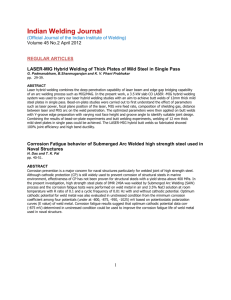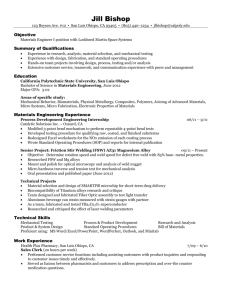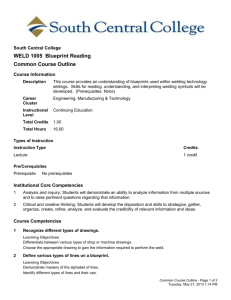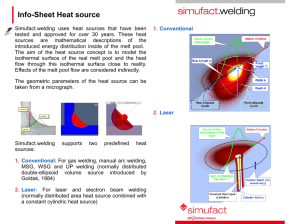Appendix 5 Advanced Weld Overlay Technology
advertisement
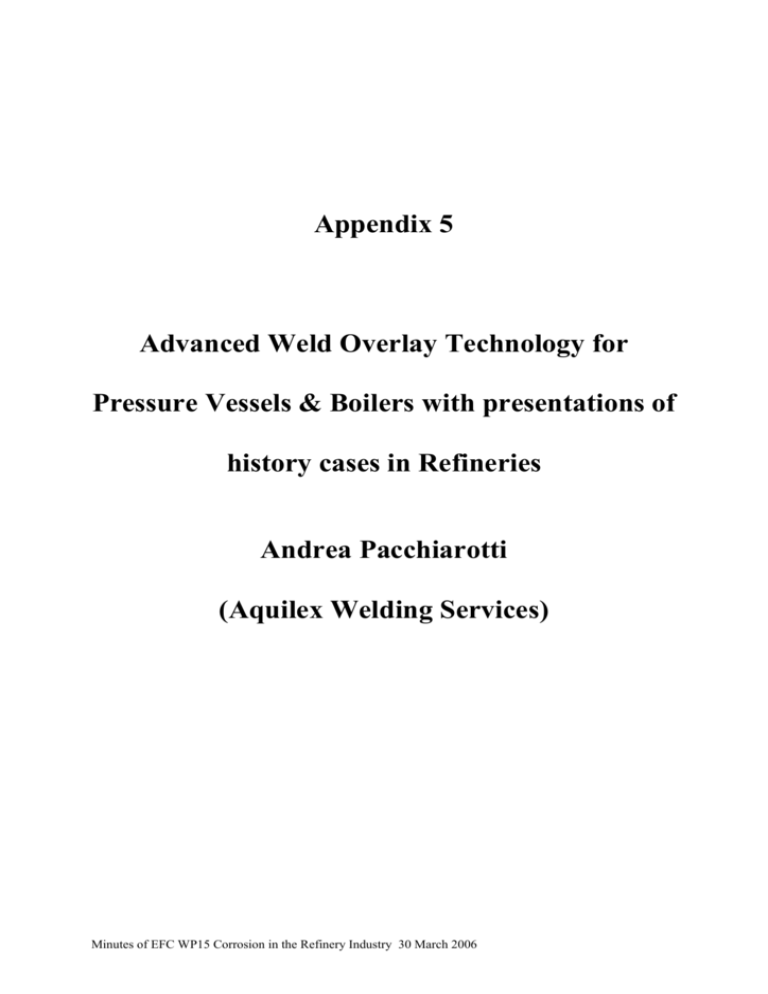
Appendix 5 Advanced Weld Overlay Technology for Pressure Vessels & Boilers with presentations of history cases in Refineries Andrea Pacchiarotti (Aquilex Welding Services) Minutes of EFC WP15 Corrosion in the Refinery Industry 30 March 2006 Advanced Weld Metal Overlay Technology for Pressure Vessels & Boilers with presentations of history cases Mike Welch - Aquilex Welding Service U.S.A. George Lai - Aquilex Welding Services Consultant Andrea Pacchiarotti –Aquilex Welding Service s Italia WSI EUROPE WSI Spijkenisse Netherlands Corporate Headquarters Atlanta Georgia, USA 25 years experience in Automated Welding ¾ Design and Build automated Welding Equipment ¾130’000 m2 of weld overlay ¾1.8 milions of Kg Wire applied Refineries & Chemicals 30% Other 5% WtE 20% WSI EU SHOP Tubi Rivestiti e Pareti Membranate Radom - POLONIA ¾ Logistic Headquarter in The Netherlands and Manufactory Facility in Poland ¾ 600 plus trained and qualified weld operators ¾ Officies in several Countries around the world Yearly Performances: 500 Projects 25 % 20% Pulp & Paper Power Generation 300 emergency on site job 20’000 m2 of weld overlay 1 • In the past, Weld Overlay was considered to be a temporay Repair Solution • Today, Weld Metal Overlay (Unifuse® Solution by WSI) is an advanced welding technology that delivers Permanent Repair & Upgrade Solutions (it permits to your plant to reach higher performances) What is Weld Overlay ? Unifuse® Weld Overlay is: A System Developed Approach to provide Corrosion or Erosion/Corrosion Protection for Major industrial Process & Boiler Plant Alloy Component Weld Overlay Applications ER309L External Weld Overlay for Atmospheric Protection ER317L Vessel Weld Metal Overlay Naphthenic Acid Corrosion Monel 400 Vessel Weld Metal Overlay HF Service Applications Inconel 622 Inconel 625 Sulphur Corrosion Applications, Low Ph and high Erosion application Hastelloy C-2000 Hastelloy C 276, C 22 Low Ph agreessive chemical process protection 2205 – 2209, 312 Duplex and Super Duplex SS for Vessel Overlay ER70S-7 Carbon Steel Build-Up for Wall Restoration Where is weld overlay a repair / upgrade solution ? ¾ Weld Metal Build-up One or more layers of weld metal applied to the base metal to obtain desired properties or dimension. ¾ Corrosion Resistant Overlay Dissimilar weld metal deposit on base metal to deter corrosion/erosion. 2 Unifuse® Weld Overlay ¾ Pulse Spray Gas Metal Arc Welding (PSGMAW) ¾ Higher Welding Speed compared to automatic equipments ¾ Fully Automatic & Programmable Machines ¾ Multiple Machines Operate Simultaneously ¾Consistent welding Parameters & Quality ¾ Broad selection of Alloys Available ¾Closed-Loop Process Control Weld Parameter Controls ClosedClosed-Loop Process Control ¾ GMAW: Wire Speed, Volts, AHC ¾ GTAW: Wire Speed, Amps, AVC ¾ Deposition Rate ¾ Heat Input ¾ Bead Placement 3 Microstructure Density Alternative Unifuse® Quality Composition 1. Homogenous Overlay, < 7% Diluition 2. Fusion Boundary, < 10 - 12% Diluizione 3. Metallo Base Unifuse® weld overlay Process Characteristics Unifuse® 180 Unifuse® 360 SMAW Total Heat Input (Joules/Sq.Ft) 450,000 400,000 1,600,000 Thickness Tolerance (mm) .010 .005 0.20 Low .010 Low .010 Smooth Extremely Smooth Depth of HAZ (mm) Surface Profile High .040 ° Rough * Alloy 625, wire data Temperature (°C) Tensile Strength MPa Yield Strength at 0.2% Elongation in 2.0 in. Room 786 (905)* 460 (490)* 54 (48,5)* 315 660 383 45 426 645 376 53 537 614 360 48 650 600 354 42 4 Pressure Vessel Solutions Reliability Considerations • Environmental Driven Modifications • Feed Stock Changes • Design Modifications • Life Extension • Corrosion Under Insulation (CUI) 5 Options? • Component Replacement • Mechanically Bonded Linings (No Restoration Strength) –Refractory –Thermal Spray –Strip Lining • Manual “Pad” Welding The WSI Solution Unifuse ® 6 What is Unifuse®? • Unifuse® is: – A Comprehensive Program for Delivering Optimized Automated Weld Overlay Performance Properties. Vertical Down Horizontal Unifuse® Technology • Applies optimal weld chemistry – Controls all weld parameters – Lowest dilution achievable – Real-time display • Recent improvements – PLC Controlled – Proportional Automatic Height Control – Proprietary Wire Feed System – Watchdog system 7 Unifuse® Technology • Applies optimal weld chemistry – Controls all weld parameters – Lowest dilution achievable – Real-time display • Recent improvements – PLC Controlled – Proportional Automatic Height Control – Proprietary Wire Feed System – Watchdog system Typical Applications • • • • • • • • • • • Vessels Towers Columns Bottom & Top Heads Transitions Nozzles Heat Exchangers Horizontal Drums ID Piping OD Piping Plate for Fabrication 8 History cases Unifuse® for Insulation Corrosion • • • • • • • • • • Facility : UK Refinery Plant Item : Coking Vessel Damage : Under Insulation Corrosion Location : Knuckle of top dome No. of Vessels : 2 Vessel diameter : 6.2 mtrs Overlay Area : 20 m2 per vessel Overlay thickness : Minimum 7.0 mm Material : Carbon Steel Program : 9 days utilising multiple automatic welding systems Unifuse® for Insulation Corrosion 9 Repair of Solvent Dehydration Tower BP Amoco – Decatur Refinery Customer Challenge • Solvent dehydration tower • Tower details: – – – – SA-240-316L material 165 foot tall 13 foot ID Original wall thickness 0.800” • Turnaround inspection: – Reveals corrosion of bottom section due to chemical attack – Vessel wall thickness as low as 0.250” • Issue: – 62” opening in the middle of the overlay zone 10 Customer Challenge Client options: • Replacement: – Lead time: 8 months • Pad welding: – Already been done by general contractor with long schedule & poor quality • Weld overlay concerns: – Distortion of manway WSI Approach Engineered Repair Design: • Perform Finite Element Analysis of overlay zone • Prediction: – No distortion beyond design engineered limitations – Deflection of manway to be less than 1% – Application methodology optimized for safety, quality, and productivity 11 WSI Approach • Results • Restored pressure boundary with two layers of 316L • Applied Alloy 625 over buildup areas as well as lower vessel section – Model within 1% of measured distortion – Cost savings of over $2.5 million – Time savings of over 1 week BP HHT-701 Dehydration Tower Predictive Distortion Analysis Validation 156.00 155.75 155.50 155.25 Measurements after overlaid 155.00 154.75 154.50 Predicted Distortion 154.25 154.00 0 2 4 6 8 10 12 Elevation (feet) Horizontal Weld Overlay Separators 12 Horizontal Weld Overlay Horizontal Weld Overlay 13 Horizontal Weld Overlay Automatic Overlay inside Vessel bores and nozzles Horizontal drum repair BP-Amoco - Prudhoe Bay Upstream Facility 14 Customer Challenge • • • • • Upstream facility in Alaska Slug Catcher: ASME Section VIII, Div 2 pressure vessel Corrosion on bottom 1/8 of entire vessel length 800+ square feet below minimum wall thickness Schedule, schedule, schedule: Any downtime associated with component shut down the entire plant 100 feet 18 feet Customer Challenge Client options: • Pad Weld: – Schedule: unknown – Quality: unknown – Post weld heat treatment required • Automated Unifuse weld overlay – Schedule: less than 40 days worst case – Quality: Unifuse technology – Post weld heat treatment eliminated through temper bead • WSI Welding Engineering developed appropriate weld procedures 15 WSI Solution Weld procedures: • Groove – Temperbead GMAW buildup with ER70S-7 (2 layers) – GMAW buildup with ER70S-7 (1 layer) & ER309LSi temperbead – SMAW E7018-H4 buildup on nozzle/shell intersections • Corrosion-resistant overlay – GMAW ER309LSi – GTAW ER309L for nozzle overlays WSI Solution Implementation Plan: • Vessel prepared by others – Internals removed, hydrogen bakeout • Sandblast vessel • Perform visual & UT inspection • Surface preparation by grinding and gouging • Perform weld metal build-up – Areas requiring one layer of 70S-7 buildup uses one layer of ER309Lsi for tempering (shown on the right) – Areas requiring two layers of 70S-7 buildup uses 70S-7 for temperbead • Perform visual & UT inspection of buildup areas • Perform ER309LSi overlay on areas: – Two layers of 70S-7 – No base metal buildup 70S-7 ER309LSi ER309LSi 16 WSI Solution Results: • Schedule: work completed in vessel in only 34 days • Production loss nominal based on project occurring during a planned turnaround • Zero wall wastage to date Weld overlay repair of high pressure separator vessel ChevronTexaco El Segundo Refinery 17 Customer challenge • VRDS Plant (Vacuum residuum desulfurization) • Critical component in unit • High Pressure Separator – – – – SA 516, Grade 70 6’ diameter 43’ tall 5.5” thick Customer challenge Customer issue: • Belzona installed 18 months earlier • Visual inspection reveals Belzona is falling off • Bottom third of vessel requires repair • Wall thickness below t-min • Schedule, schedule, schedule 18 Partial Customer List Allied Signal ConocoPhillips Lyondell Chemical Amerada Hess Eastman Chemical Marathon Ashland Aristech Chemical Equistar Methanex Arizona Chemical ExxonMobil Millennium Chemical BASF Farmland Industries Monsanto Chemical Bayer Chemical Flint Hill Resources Noveon BP Amoco Formosa Plastics Oxychem Chalmette Refining GE Plastics PDVSA ChevronTexaco Goodyear Pennzoil ChevronPhillips Hunt Refining Phillips 66 Citgo Petroleum Huntsman Chemical Tesoro Petroleum Clark Refining LaRoche Shell Oil Coastal USA Linde Gas Sunoco Coastal Aruba Motiva Valero WSI Solution • Client contacts WSI – WSI on-site in 48 hours with supervision – Equipment on-site within 72 hours • High preheat of 250ºF required – Safety plan developed to ensure safe work environment 19 WSI Solution • Project Execution – Removed Belzona by grit blasting – Grinded out pits – Performed weld buildup on 150 ft2 – Provided corrosion resistant overlay on 300 ft2 • Executed project in 10 days Catalyst Tube Flange Repair Suncor – Sarnia Refinery 20 Customer Challenge • Methane Steam Reformer Furnace – 156 HP35 Catalyst 3” Tubes • Client Issue: Cracking of Lower Flange weld – HP35 to Carbon Steel – Limited access for manual welding – Caused by low temperature condensation – resulting in oxidation Customer Challenge • Additional concerns – Cracking in the original weld – Corrosion around original weld area • Client options – Complete replacement of catalyst tubes – Dismantle lower furnace to create access for manual welding – WSI approach 21 WSI Solution WSI Alternative: • Perform weld from the inside of the tube 3” – Utilize ID machining tool – Cut existing flange and perform new weld prep in one step – Install new flange with auto GTAW ID weld head WSI Solution WSI Approach: • Developed an integrated tool to perform the machining and welding • WSI used a consumable insert to make the root pass • Equipment is not commercially available for purchase 22 WSI Solution Results: • Inspections showed 77 flanges needed to be replaced • WSI handled all machining and welding • Four integrated systems completed the work in 4 days • ID of tube weld overlaid with alloy 625 with same system • Zero rejects Heavy Wall Piping • Seamed hot reheat piping replacement • P-91 material • Worked performed from 2000 to 2002 • 170 Critical joints – Ranged from 18” diameter to 32” diameter – Three small rejects 23 Partial Customer List Allied Signal ConocoPhillips Lyondell Chemical Amerada Hess Eastman Chemical Marathon Ashland Aristech Chemical Equistar Methanex Arizona Chemical ESSO Refinery Millennium Chemical BASF ExxonMobil Monsanto Chemical Bayer Chemical Farmland Industries Noveon BP Amoco Flint Hill Resources Oxychem Chalmette Refining Formosa Plastics PDVSA ChevronTexaco GE Plastics Pennzoil ChevronPhillips Hunt Refining Statoil Citgo Petroleum Huntsman Chemical Tesoro Petroleum Clark Refining LaRoche Shell Oil Coastal USA Linde Gas Sunoco Coastal Aruba Motiva Valero 24 Appendix 6 Thermal spray coatings Dave Harvey (TWI) Minutes of EFC WP15 Corrosion in the Refinery Industry 30 March 2006 EFC-NACE Italia Section Joint Meeting, Venezia 31 March 2006 Thermal Spray Coatings David Harvey dave.harvey@twi.co.uk tel +44 1223 891162 Thermal Spraying Wire Electric arc Powder Flame 1 TSCs for Corrosion Mitigation • “Anodic” materials such as Al, Zn etc protect carbon steel • “Noble alloy” coatings must provide a physical barrier between substrate and corrosive medium Galvanic series HVOF Stainless Steel 316L Coatings JP5000 316L JP5000 Ni 625 DJ 316L DJ Ni 625 2 Ni Alloy Coatings Surface after corrosion testing Stainless Steel 316L 600 Potential, mV SCE 400 Wrought SS 316L Eb 200 JP 0 Eb TG -200 DJ HV -400 -600 0.0001 0.001 0.01 0.1 Current density, mA/cm 1 10 2 3 Ni Alloy 625 800 JP 600 Potential, mV SCE DJ 400 Wrought nickel 625 200 HV TG 0 -200 -400 -600 0.0001 0.001 0.01 0.1 1 10 Current density, mA/cm2 Pitting corrosion in substrate Test cell position Coating / substrate interface 4 Nickel Alloy 625 Coatings Localised corrosion attack of coating extending along interinter-particle (splat) boundaries No penetration through coating or corrosion of underlying steel substrate (in this example) Spray Technology Position Particle velocity Cold spray Cool HVOF / Warm spray Finer particle size Conventional HVOF Increased thrust Lower heat input Arc, flame, plasma Particle temperature 5 Fine Powder Cool HVOF (C-CJS) • Very fine powders • Very high particle velocity • H2 atomised kerosene fuel • Lower power 80kW ID CoolFlow Internal HVOF Process • Superfine powders need less thermal energy • Shorter stand-off distance 6 Cold Spray System Powder feed unit Powder Feed Pressurised Gas Supersonic Flow Cu coating Gas heater (induction coil) High pressure, high flow gas supply Carrier gas supply Ti coating Mitigation of Corrosion using Thermally Sprayed Aluminium (TSA) 7 TSA Joint Industry Projects • Current & completed projects: (primarily offshore) – JIP 13458: Improving the reliability and cost performance of TSA on C-steel (completed April 2003) – JIP 14661: TSA coatings for prevention of corrosion of 22Cr DSS at elevated temp. (completed May 2005) • Use of TSA to mitigate CUI for 22Cr DSS and 316L SS – PR 9232: TSA coatings for prevention of corrosion & EAC of welded CRAs (25Cr SDSS, 22Cr DSS, 12Cr SMSS, 316SS) • New projects - most relevant to the Refinery Industry: – PR 9483: Prevention of corrosion under insulation (CUI) of steel with TSA (launch May 2005) – PR 10419: Thermal spray coatings for corrosion mitigation: State-of-the-art (launch May 2005) JIP13458: Thermal Spray Process Benchmarking Study Flame Spray Arc spray Purecoat Spray jet Shielding inert gas Gas shroud Arc jet Plane of substrate Arc point Inert gas Air Conventional systems New systems HVOF wire 8 JIP 13458 & JIP14661: Performance of Sealed TSA Coatings Polyamide epoxy sealant TSA Substrate Aluminium silicone sealant TSA Substrate Ecorr and Corrosion Rate of TSA -400 -600 Corrosion Rate 0.10 -600 -800 0.10 Ecorr -800 -1000 Ecorr 0.01 -1000 -1200 0.01 Calc. Corrosion rate Calc. Corrosion rate Potential 0.00 0 5 0 5 -1200 -1400 -1400 -1600 10 15 20 25 30 10 Time (days) 15 20 25 30 0.00 Ecorr (mVsce) Ecorr (mVsce) LPR Calc. Rate (mm/yr) LPR Corrosion Calc. Corrosion Rate (mm/yr) -400 -1600 Time (days) • Ecorr ~ 1050mVsce and CR of TSA stabilise after about 15-20 days • Stable corrosion rate of TSA ~ 6-8µm.yr-1 in seawater at 80°C, pH 7.8-8.0 9 HISC Test Connection Connection to to potentiostat Potentiostat Extensometer Extensometer Section of failed sample - no TSA Test Tensile specimen specimen Pt anode Pt anode Reference Reference cell cell Rubber seal Rubber seal TSATSA-coated sample with simulated damaged JIP13458: High Temperature Seawater Test Rig Cold saltwater Control room Freezer room Hot oil tank Water level Sand level 10 TSA Review - Joint Industry Project • PR10419: Thermal spray coatings for corrosion mitigation: State-of-the-art (launch May 2005) • Objectives: – – – – • State-of-the-art report, experience, concerns Best practice guidelines Benchmark technically & economically Identify technology gaps Work scope: – – – – – Assets and components Service duty and environment Standards and codes of practice Thermal spraying processes & materials Application issues, health & safety and environment, QA/QC 11 Appendix 7 The role of technical societies and working parties in the management of knowledge Giovanna Gabetta (ENI E&P) MarinoTolomio (VeneziaTecnologie) Minutes of EFC WP15 Corrosion in the Refinery Industry 30 March 2006 The role of technical societies and working parties in the management of knowledge Giovanna Gabetta, Eni Div. E&P Marino Tolomio, VeneziaTecnologie Refinery Corrosion Working Party EFC & Nace, Italy Section March 31, 2006 LS Knowledge Management •New information systems and tools, new communication facilities increase the amount of information available at a speed that was not conceived until a few years ago •Increasing importance to “intangible assets” and knowledge - essential for the competitive advantage •There is a need to find, select, organize, elaborate, and present information in a way that improves the performance of employees and organizations in a specific area of interest LS 1 •Knowledge management (KM) helps an organization to gain insight and understanding from its own experience •Specific KM activities help focus the organization on acquiring, storing, and utilizing knowledge for such things as problem solving, dynamic learning, strategic planning, which are in summary a support to decision making LS KNOWLEDGE • Explicit, or Codified Knowledge: information and rules mainly in written form, as for instance project reports, contracts, process diagrams, lists, and explanations of lessons learnt and case studies, with books, manuals, company standards, and best practices, in summary documents and publications easily searchable, in addition to data and information with high added value, particularly those which come from experience internal to the system. • Tacit, or Personal Knowledge is not codified, difficult to become formal, based on practical experience, short-lived and volatile. It is based in the knowledge patrimony of people, and people only can make it explicit via direct contact with other people. It is a weak but important asset of the company culture, since it is above the behaviour of the company members. • Explicit knowledge is estimated to be only about 20% of the total amount of knowledge in a company. The remaining is tacit knowledge, which is normally shared only for a small amount. One of the important challenges of KM is to provide tools to share the tacit knowledge, which is a personal asset of the human beings in a company LS 2 Collect and share knowledge • Explicit knowledge can be managed inside an Information and Communication Technology (ICT) system. • To manage tacit knowledge, people must communicate: informal and individual networks connecting people, helping to solve the daily problems • Unfortunately, often no track record remains of such knowledge exchanges (typically, they happen verbally and/or by phone, without recording) • There is a need of organizing the knowledge. There is a need for places where tacit knowledge can become esplicit LS KM Systems • Knowledge Management systems are aimed at facilitating and speeding up the sharing of best practices, lessons learned, and other know how inside the organizations • The above systems are based on ICT tools (portals, data bases, research engines) to organize and present explicit knowledge • Virtual Communities help to • Virtual Communities are groups of people who interact using information tools (e-mail, chat, video conferences and so on) having a possibility to record and retrace the contacts; they help building relationships between people and sharing esplicit knowledge LS 3 Communities of practice • Communities of Practice (CoP) are virtual communities made up of people who share a passion for something that they know how to do and who interact regularly to learn how to do it better • Communities facilitate and speed-up the sharing of best practices, lessons learned and other ‘know how’ across the organisation LS Workflow for a Problem Solving Community Problem! / Searching (tacit) CoP Member Notification + Dispatching User / Professional Central Explicit Knowledge Database Solution Submission e-mail CoP Mailbox Procedures Standards Best Practices MyDoc ::::::::: Answers on experience CoP Member e-mail e-mail Solution! automatically dispatches to ... Answers on experience Answers on experience + search in the KDB • Sorry …. • Try ….. • Solution is…. • Do not try…. • Sorry …. • Try ….. • Solution is …. • Do not try…. • Sorry nothing in KDB • Solution found in KDB User/Professional e-mail Collaboration Netmeeting, …. e-mail CoP Member e-mail e-mail CoP Leader ( Enabling Team Representative ) Answers on experience + search in the KDB Searching ( tacit + explicit ) CoP Members Validation e-mail Notification e-mail e-mail After Action Report Submission CoP Leader a) Inserting BP in prevalidated KDB b) Inserting Validated BP MyDoc ACL Workflow Central Tacit Knowledge Database Central Tacit Knowledge Database LS 4 WHY A MATERIALS CoP? The importance of being a “User” of materials - mainly of structural materials – is nowadays growing in the industry In Eni Group, competencies on materials are widespread and transversal LS FACTORS OF IMPORTANCE • Increasing severity of the environment for new installations (deep water, permafrost…) • Increasing aggressiveness of crude oil(water cut, sulphur content) • Increasing age of plants and components • Strategic importance of operating plants worldwide • New aptitude – especially in Europe and US – toward the responsibility of Users in Health, Safety and Environmental issues Experience and knowledge in the field of Materials are necessary to support decision • Design • Inspection • Maintenance • problem shooting • fitness for service… LS 5 Money spent somewhere can be saved elsewere Problemsmistakes TechnologyInnovation Preventive actions Collecting and sharing experience: CoP Materials Good management and organization OPTIMIZATION LS Members of the Materials Cop have an experience in: Materials properties Inspection and control Risk assessment Damage mechanisms and their prevention Corrosion Management LS 6 Mission of the CoP “Materials” • Promote and support development and diffusion of knowledge in the field of structural integrity of materials for oil & gas industrial plants • Realize a survey of needs and resources inside the Group • Implement and share the Group experience Data base LS CoP boundaries • Domain: the definition of the area of shared inquiry and of the key issues • Community: the relationships among members and the sense of belonging • Practice: the body of knowledge, methods, stories, cases, tools, and documents LS 7 A space for a CoP Space for meetings (physical) Space for relationship portal, mail (interaction, emotion, thinking) Tacit Space ideas, proposals (creativity, proactivity, energy) LS CoPs and scientific associations • Can a scientific association be a CoP? • Small groups of specialists (named Technical Committees, Working Parties or the-like..) who meet regularly and organize events • Web site and communication via mail EXAMPLE • The European Federation of Corrosion is organized in Technical Committees (TCs) • Each of these TCs focuses on selected aspects of corrosion and attracts experts from all over the world LS 8 The role of associations • Associations and TCs can act as a Knowledge Management System with the objective of facilitating and speeding-up the sharing of best practices, lessons learned and other ‘know how’ across the scientific community LS FUTURE WORK • The contribution to a KM system by a TC such as Refinery corrosion group could be: • Realizing a survey of needs and resources; • Preparing, implementing and sharing an experience Data Base • Support the creation and successful life of the international network. LS 9 CONCLUSIONS • The Management of Knowledge and the solution of complex technical problems in a global world is an important challenge for the future. The contribution of existing networks such as technical associations and Working Parties (Communities of Practice) is very important to enhance the cooperation between scientists and experts all over the world LS 10 Appendix 8 Cases of failure analysis in industrial plants Sergio Volontè (Tecnimont) Minutes of EFC WP15 Corrosion in the Refinery Industry 30 March 2006 Case of failure analyses in industrial plants HEAT EXCHANGER KETTLE TYPE: CORROSION OF THE TUBE BUNDLE Author dr. Sergio Maria Volonté Corrosion & Painting Group Leader Case of failure analyses in industrial plants z ITEM: KETTLE USED AS EVAPORATOR z FLUID SHELL SIDE: WATER SOLUTION OF POTASSIUM CARBONATE in 3.6% (pH = 8.3) → out 18.1% (pH = 10.7) TUBE SIDE: PROCESS GAS z OPERATING CONDITIONS TEMPERATURE (PRESSURE) SHELL SIDE: 145 °C (5.3 bar g) TEMPERATURE (PRESSURE) TUBE SIDE: in 250 ÷ out 156 °C (32 bar g) z MATERIAL OF CONSTRUCTION: STAINLESS STEEL UNS S30400 z TUBE - TUBE SHEET JOINT: STRENGTH WELDING PARTIALLY MECHANICAL EXPANDED WITHOUT GROOVES z FAILURE PLACE: FREE SURFACE LOCALIZED BETWEEN THE TUBE AND THE TUBE SHEET, SHELL SIDE z SERVICE LIFE BEFORE FAILURE: 2 MONTHS 1 Case of failure analyses in industrial plants KETTLE: KETTLE:GENERAL GENERALSKETCH SKETCH Case of failure analyses in industrial plants THE THETUBE TUBESURFACE SURFACEUNDER UNDERTHE THETUBE-SHEET TUBE-SHEETWAS WASFOUND: FOUND: - - PART PARTOF OFTHE THE TUBE TUBE MECHANICALLY MECHANICALLYEXPANDED EXPANDED (ABOUT (ABOUT 60 60 mm): mm): BRIGHT BRIGHT AND ANDTHE THE THICKNESS THICKNESSEXTREMELY EXTREMELYTHIN. THIN. - - PART PART OF OF THE THE TUBE TUBE NOT NOT MECHANICALLY MECHANICALLY EXPANDED EXPANDED (ABOUT (ABOUT 80 80 mm): mm): MATT MATT AND AND FREE FREEFROM FROMCORROSION. CORROSION. SURFACE SURFACENOT NOT MECHANICALLY MECHANICALLY EXPANDED EXPANDED SURFACE SURFACE MECHANICALLY MECHANICALLY EXPANDED EXPANDED 2 Case of failure analyses in industrial plants DETAIL DETAILOF OFTHE THEPREVIOUS PREVIOUSPHOTO: PHOTO:THE THEBREAKING BREAKINGHAPPENED HAPPENEDDURING DURINGTHE THE REMOVING REMOVINGOF OFTHE THETUBE TUBEFROM FROMTUBE-SHEET: TUBE-SHEET:THE THETHICKNESS THICKNESSWAS WASTOO TOOLOW. LOW. Case of failure analyses in industrial plants z - TESTS AND RESULTS CARRIED OUT IN THE LAB: CHEMICAL ANALYSIS OF THE MATERIAL OF CONSTRUCTION: CONFIRMED THAT WAS UNS S30400 METALLOGRAPHIC EXAMINATION: CONFIRMED THAT: THE MATERIAL USED FOR CONSTRUCTION WAS PLACE IN SERVICE SOLUTION ANNEALED THE SURFACE INTERESTED BY CORROSION SHOWED A “WAVED” PROFILE, FREE FROM LOCALIZED CORROSION (PITS AND INTERCRYSTALLINE CORROSION) CHEMICAL ANALYSIS OF THE K2CO3: THE CONTENT OF CHLORIDES IN THE CONCENTRATED SOLUTION WAS LESS THAN 100 ppm, VALUE CONSIDERED “NEGLEGIBLE” IN ALKALINE SOLUTION 3 Case of failure analyses in industrial plants z USEFUL INFORMATION THE AQUEOUS SOLUTIONS OF POTASSIUM CARBONATE, WHEN OVERHEATED, ARE SUBJECTED TO HYDROLISIS PRODUCING POTASSIUM HYDROXIDE AND CARBON DIOXIDE. THE CHEMICAL REACTION IS THE FOLLOWING: K2CO3 + H2O → 2 KOH + CO2 THE NEXT TABLE, ONLY AS EXAMPLE, SHOWS THE RATE OF DECOMPOSITION OF AN AQUEOUS SOLUTION 0.2N OF K2CO3 BOILED UNDER REFLUX AT ATMOSPHERIC PRESSURE. Case of failure analyses in industrial plants KK2CO 3 0.2N 2CO3 0.2N CORRESPONDS CORRESPONDS TO TO2% 2%w/w, w/w,THIS THIS VALUE VALUEOF OF CONCENTRATION CONCENTRATION IS ISCOMPARABLE COMPARABLE TO TOTHE THEKETTLE KETTLE FEED FEEDAQUEOUS AQUEOUS SOLUTION SOLUTION 8180 8180minute minute CORRESPOND CORRESPOND TO TOLESS LESSTHAN THAN66 DAYS DAYS FROM: FROM:MELLOR’S MELLOR’S––COMPREHENSIVE COMPREHENSIVETREATISE TREATISEON ONINORGANIC INORGANICAND AND THEORETICAL THEORETICALCHEMISTRY CHEMISTRY––VOL. VOL.IIII––SUPPLEMENT SUPPLEMENT33––1963 1963- -LONGMANS LONGMANS 4 Case of failure analyses in industrial plants z CAUSE OF THE FAILURE THE CORROSION PRIMED ON THE TUBE SURFACE HAS BEEN ATTRIBUITED TO THE WRONG MECHANICAL DESIGN WITH THE FORMATION OF A CREVICE BETWEEN THE TUBE AND TUBE-SHEET. THE HYDROLYSIS OF THE K2CO3 WITH THE PRODUCTION OF A STRONG ALKALI SUCH AS KOH IS ONLY A CONSEQUENCE OF A WRONG DESIGN OF THE EQUIPMENT. IN FACT, INSIDE THE CREVICE THE FOLLOWING HAPPENDED: - HIGH EVAPORATION OF THE WATER THAT INCREASE THE ALKALI CONCENTRATION; LOW REDUCTION OF THE WALL TEMPERATURE DUE TO THE LITTLE VOLUME OF THE AQUEOUS SOLUTION. THE MATERIAL OF CONSTRUCTION: UNS S30400, IS CHARACTERIZED BY ACTIVE / PASSIVE BEHAVIOUR. FROM LITERATURE, AT TEMPERATURE HIGHER THAN 150 °C, CONCENTRATED SOLUTIONS OF KOH CAUSE HIGH CORROSION RATE OF UNS S30400 (ACTIVE BEHAVIOUR). Case of failure analyses in industrial plants z 1. 2. z ADOPTED SOLUTIONS EXTENSION OF THE MECHANICAL EXPANSION OF THE TUBE FOR ALL THE THICKNESS OF THE TUBE SHEET. THIS MODIFICATION HAS AVOIDED THE PRESENCE OF THE CREVICE. INSERTION OF FERRULES INSIDE THE TUBES FOR REDUCING THE THERMAL CONDUCTIVITY IN CORRESPONDANCE OF THE TUBE SHEET. FEED-BACK FROM FIELD THE HEAT EXCHANGER HAS BEEN IN OPERATION FOR AT LEAST TWO YEARS (PERIOD WHICH TECNIMONT HAS PROVIDED ASSISTANCE TO CLIENT) WITHOUT ANY FAILURE. 5 Case of failure analyses in industrial plants z 1. 2. z OTHERS POSSIBLE SOLUTIONS SUCH AS: JOINT TUBE SHEET - TUBE BY BORE-WELDING (THAT IS A BUTT WELDING BETWEEN THE TUBE SHEET AND THE TUBE); CHANGE OF THE MATERIAL OF CONSTRUCTION TO NICHEL OR ITS ALLOYS; HAVE BEEN CONSIDERED TOO MUCH EXPENSIVE FOR THE SERVICE. FINAL CONSIDERATIONS THE INSERTION OF THE FERRULES AND THE EXTESION OF THE MECHANICAL EXPANSION HAVE SOLVED DEFINETELY THE ORIGIN OF THE FAILURE. 6

